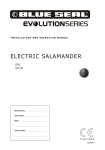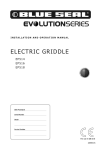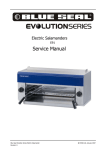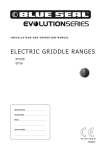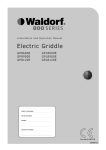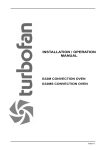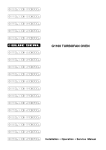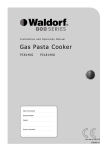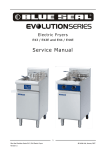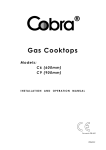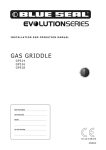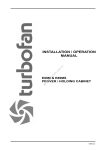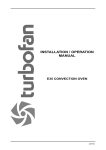Download Moffat TURBOFAN E20M Specifications
Transcript
E1100 TURBOFAN OVEN -1- MANUFACTURED BY Moffat Limited PO Box 10001 Christchurch New Zealand Ph: (03) 389 1007 Fax: (03) 389 1276 WORLD-WIDE BRANCHES UNITED KINGDOM Blue Seal Unit 67, Gravelly Business Park Gravelly Park Birmingham West Midlands B24 8TQ Ph: (121) 327 5575 Fax: (121) 327 9711 UNITED STATES Moffat Inc 3765 Champion Blvd Winston-Salem North Carolina 27115 Ph: (336) 661 0257 Fax: (336) 661 9546 CANADA Serve Canada 22 Ashwarren Road Downview Ontario M3J1Z5 Toll Free:800 263 1455 Ph: (416) 631 0601 Fax: (416) 631 0315 [email protected] www.servecanada.com www.moffat.com NEW ZEALAND Christchurch Moffat Limited PO Box 10-001 16 Osborne Street Christchurch Ph: (03) 389 1007 Fax: (03) 389 1276 Auckland Moffat Limited 4 Waipuna Road Mt Wellington Auckland Ph: (09) 574 3150 Fax: (09) 574 3159 AUSTRALIA Victoria New South Wales Moffat Pty Limited 740 Springvale Road Mulgrave, Melbourne Victoria 3171 Ph: (03) 9518 3888 Fax: (03) 9518 3838 Moffat Pty Limited 3/142 James Ruse Drive, Rose Hill PO Box 913, Smithfield Sydney, N.S.W. 2142 Ph: (02) 8833 4111 Fax: (02) 8833 4133 Western Australia Moffat Pty Limited 67 Howe Street Osbourne Park WA 6017 Ph: (08) 9202 6820 Fax: (08) 9202 6836 Queensland Moffat Pty Limited 30 Prosperity Place Geebung, Brisbane Queensland 4034 Ph: (07) 3630 8600 Fax (07) 3630 8623 The reproduction or copying of any part of this manual by any means whatsoever is strictly forbidden unless authorized previously in writing by the manufacturer. In line with policy to continually develop and improve its products, Moffat Ltd. reserves the right to change the specifications and design without prior notice. © Copyright Moffat Ltd. December 2007. -2- E1100 TURBOFAN OVEN CONTENTS PAGE INTRODUCTION 5 INSTALLATION 6 OPERATION 8 COOKING GUIDE 10 CLEANING 12 SERVICING 13 SPARES 16 DOUBLE UNIT ASSEMBLY 17 CIRCUIT SCHEMATIC 18 Date Purchased.................................................................................... Serial No...................................... Dealer........................................................................................................................................................... Service Agent.............................................................................................................................................. F15058-12 -3- -4- INTRODUCTION We are confident that you will be delighted with your TURBOFAN OVEN, and it will become the most valued appliance in your kitchen. Your new oven may seem very complex and confusing at first glance. To ensure you receive the most benefit from your new turbofan, there are two important things you can do. Firstly Please read the instruction book carefully and follow the directions given. The time taken will be well spent. Secondly If you are unsure of any aspect of the installation, instructions or performance of your oven, contact your BLUE SEAL dealer promptly. In many cases a phone call could answer your questions. -5- INSTALLATION It is most important that the oven is installed correctly and that the operation is correct before use. Installation must comply with local gas, electrical, health and safety requirements. BEFORE CONNECTION Unpack oven and check for damage. Report any damage to the carrier and dealer. Report any deficiencies to your dealer. To Fit Legs - Single Unit Tilt the oven over on one side and fit both the front and rear legs to the side now off the ground. Fit them into the base frame under the chassis base and secure to the base with the bolts, spring washers and flat washers provided. Lift up the other side of the oven, fit legs, bolts and washers, but do not tighten yet. Position leg tray (flat side facing up) between legs and secure with 4 screws provided, then tighten all leg bolts. Level the oven by adjusting the feet. To Fit Legs - Double Unit Fit and secure 4 short legs onto the bottom unit by the method described above. NOTE: There is no leg tray for the double unit. Lay the top unit on its side and fit the spacers provided to the base of the oven. Lift the top unit onto the bottom unit and secure around the spacer panel flanges with self-tapping screws provided. Fit chimneys over the duct assembly of the bottom unit. Screw in place and pull down chimney surrounds onto the duct assembly. Level the oven by adjusting the feet. ELECTRICAL CONNECTION This E1100 convection oven can be supplied as single or twin deck unit and are to be connected to a 400 - 415V A.C. 3 phase, neutral and earth supply. Refer to the rating plate for loading per phase. The mains terminal block is positioned at the left rear of the unit. Access is provided by a detachable panel on the back panel. Each oven should be connected to a circuit breaker (or switch and fuses). These should be mounted on the wall adjacent to the oven and should be readily accessible and clearly marked. Bring the connecting cable up through the base panel and tighten the conductor strands securely to the terminal block studs. The earth screw is located in the base panel next to the cable entry hole. WARNING - THIS APPLIANCE MUST BE EARTHED IMPORTANT - FIXED WIRING INSTALLATIONS MUST INCORPORATE AN ALLPOLE DISCONNECTION SWITCH. IF SUPPLY CORD IS DAMAGED, IT MUST BE REPLACED BY A SUITABLY QUALIFIED PERSON IN ORDER TO AVOID A HAZARD. -6- INSTALLATION WATER CONNECTION A cold water supply should be fitted to the water inlet which is located at the rear of the unit. To access the water solenoid, remove the 14 screws securing the rear cover panel, and remove the cover panel. Fit ½" (13mm) flexible hose to the solenoid and secure with a hose clamp. Unscrew tap (ACW) as far as possible. Turn on water supply to check for leaks. NB: It may be necessary to hold the water injection button in for a few seconds to remove air from the system after initial instalment. VENTILATION Proper ventilation is essential for good operation. It is important to have at least 100mm (4") of air space around both sides and rear of the oven. It is also necessary to consider a 300mm (12") space on the RH side to gain access to circuitry and gas connections through the access panel. However, if space is limited the minimum of 100mm (4") must still be maintained though the oven can be moved to gain access. -7- OPERATION Simply turn the power switch to "ON" and the oven control to the desired temperature. The POWER pilot light is on when power is supplied to the oven. The HEATING pilot light will cycle on/off as the thermostat keeps the oven at the set temperature by turning the elements on/off. When the oven thermostat is set and the doors are opened, the fan and elements will cease operating. Also when the doors are opened, the oven lights will turn on automatically to provide good visibility for loading and unloading. PREHEAT With the doors closed and MAINS switched "ON", set the thermostat dial to the desired temperature. As an indication of the speed of heating, the oven should reach 175° in ten minutes. If the oven is being used from cold, it is advantage to allow it to cycle for a time to offset the heat being absorbed by the oven and its insulation. BAKE TIMER This 60 minute clockwork timer is completely independent of the oven control. To set timer, turn knob clockwise to the required time. At any stage, the time can be adjusted in either direction. When the timer reaches the TIME UP position, the TIME UP light will come on and a buzzer will sound. Turn timer to the OFF position to cancel the buzzer and TIME UP light. Initially this control may be stiff to operate but will improve with use. ROAST 'N’ HOLD TIMER This 3 hour timer is electrically driven and is set by turning the knob in either direction, to the required time. The timer can be set when convenient, but will not start working until the OVEN CONTROL is set and the ROAST 'N’ HOLD is switched to START. When the timer reaches the HOLD position the oven is turned off and a PRE-SET HOLD thermostat located behind the control panel will control the oven to keep the food warm at serving temperature as long as required until the ROAST 'N’ HOLD is switched to OFF. NOTE: The HOLD light will be on when the timer reaches HOLD until the ROAST 'N’ HOLD switch is turned OFF. The hold light may come on briefly when the roast 'n’ hold control is first switched on until the oven heats up beyond the pre-set hold temperature. INSTANT HOLD To use HOLD immediately without operating the oven to cook food, set the oven control to ON and switch ROAST 'N’ HOLD to START. -8- OPERATION WATER To compensate for the loss of moisture from breads and other product while baking, water can be injected into the oven while baking. As water pressures may vary from area to area the amount of water injected into the oven will also vary and can be adjusted by a needle valve located at the rear of the oven. Use a pulse time of 1-5 seconds as required to suit the product being cooked. LIGHTS To turn on the two oven lights located at the rear of the oven, push the button. The lights will remain on while the button is held in. This will enable cooking progress to be checked without the need to open the door. To improve visibility when loading or unloading the oven, the lights will automatically come on when the door is opened, and go off when the door is closed. -9- COOKING GUIDE This BLUE SEAL TURBOFAN oven will cook a greater quantity of food faster, at a lower temperature and more evenly than an ordinary oven. As the oven opening is large and because loading to capacity takes longer than normal ovens, the temperature will drop during the loading operation. To off-set this effect, it is desirable to increase the preheat temperature by 25°C above the desired temperature. After loading is completed the thermostat should be set to the appropriate temperature for the goods being cooked. Keep loading times as short as possible to minimise heat loss. NOTE: Before cooking, set the oven control to 250°C and leave the oven to heat up for half an hour. This removes any undesirable fumes which may be in a new oven. It will take approximately 25 mins. for the oven to reach 250°C. BAKING Due to the increased efficiency of a convection oven the temperature of recipes for use in standard non-convection ovens should be decreased by up to 50°C Always load each shelf evenly. Space pans away from each other and from the sides and back of the oven to allow a maximum air-flow between them. The large tempered glass windows plus the interior oven lights permit a close check on the goods, making it unnecessary to frequently open the oven doors and hence lose heat. Check the goods in the oven more frequently than in conventional ovens because of the shorter cooking times. The time savings run from 20% to as high as 50% on certain foods. When baking we suggest you use the BAKE TIMER, as this is a warning device and will not stop the oven heating for further cooking batches. As many excellent recipe books are published, it is not our intention to list recipes, but to provide a temperature and time chart as a guide. Space is provided for you to note your own time or temperature as required. BAKING GUIDE FOOD °F °C TIME Custard Pies Sponge Puddings Yorkshire Puddings (Lrg) Yorkshire Puddings (Sml) Meringues Meringue Toppings Biscuits Sponge Cakes Scones Yeast Rolls Danish Rolls Sweet Rolls Hamburger Buns Yeast Bread 300 370 370 370 230 320 430 340 390 320 355 300 320 320 150 190 190 190 110 160 220 170 200 160 180 150 160 160 30-45 mins 10 mins 30-45 mins 10 mins 75 mins 8-10 mins 5-6 mins 15-20 mins 10-15 mins 10-15 mins 10 mins 10-15 mins 20 mins 20-25 mins -10- COOKING GUIDE ROASTING The hot air circulating in the oven reduces moisture loss and shrinkage. Turbofan roasting times are reduced by approximately 10 mins per half kilogram. The ROAST 'N’ HOLD system will automatically cook food for a set time, then hold the oven at a preset temperature indefinitely to maintain food at serving temperature after cooking has been completed. When the oven has reached the set temperature, place food in oven, set the ROAST 'N’ HOLD timer to the required cooking time and switch ROAST 'N’ HOLD to START. The HOLD light will come on when cooking is complete. Switch ROAST 'N’ HOLD off for normal oven control. ROASTING GUIDE Beef (5kg) Lamb (5kg) Turkey (10kg) Spring Chicken Chicken Pieces Braising Sausages Beef Rounds (20kg) Steaks Meat Loaf (115 x 230mm tin) Hamburger Patties Bacon Fish Fillets (110g froz) Fish Fingers Steak Pie (28g froz) Suggested Temperature °C Suggested Time Minutes 205° for 30 min then 175° 205° for 30 min then 150° 150° 175-190° 180° 150° 175° 110° 230° 150° 205° 205° 245° 205° 205° 120 150 150-180 10 40-45 20-25 15-25 9 hours 10-14 45-60 4-8 6-10 20-25 10 30 METRIC CONVERSION -11- CLEANING CAUTION: ALWAYS TURN THE POWER SUPPLY OFF AT THE WALL SWITCH BEFORE CLEANING THIS UNIT IS NOT WATER PROOF. DO NOT USE WATER JET SPRAY TO CLEAN INTERIOR OR EXTERIOR OF THIS UNIT. With the enamelled interiors, this oven is designed to be as maintenance free as possible. However for best operating results the oven should be cleaned regularly To clean interior oven parts, first remove all oven racks and side racks. Then loosen off the 4 knurled head screws at the rear of the oven and lift the fan baffle up to remove it. Place racks and baffle in ammoniated water for about 25 mins. Scrub parts off with a stiff bristled brush and dry. NOTE: When cleaning the fan, take care not to damage it, as it is properly balanced when assembled at the factory. To remove OVEN LAMP GLASS, simply unscrew anti-clockwise, clean and replace, but do not over tighten. Keep liquids away from the light sockets. If there is hardened food spillage in the oven, sprinkle the affected areas with salt, set the oven control to operate until the affected areas have charred. Then scrape clean with a spatula or blunt knife. When cleaning the exterior stainless steel panels, take care not to rub across the grain in the metal. This will ensure the oven keeps its original appearance. -12- SERVICING DOOR DOOR ADJUSTMENTS In the event of the doors not closing properly i.e. the RH door not closing slightly ahead of the LH, proceed as follows to adjust. Remove bottom shroud and striker plate at front base of the oven, secured by 4 screws on top face and one screw at either side, pull the shroud forward until it is clear. The chain and sprocket mechanism will now be exposed. Slacken off the locknuts on both turn-buckles and adjust each turn-buckle until the doors close properly. NOTE: A very slight adjustment can make a considerable difference in door closure. Refit bottom hinge shroud and striker plate. BROKEN GLASS REPLACEMENT Open the doors and on the affected door remove the screws on the sides, top and bottom edges. If it is a RH door, remove the extra screws and ball catches. Remove the two screws on the door front. Lift off the door outer, making sure that glass spacer and undamaged glass pane do not fall out. Remove all glass fragments, the glass spacer and the undamaged pane. The seals on the door inner and outer must be replaced with new ones if damaged. Replace the broken pane and refit both clean panes either side of the spacer against the seal on the door catches if it is a RH door. To facilitate the replacement of BOTH glass panes follow the same procedure as above. BALL CATCH - REPLACEMENT AND ADJUSTMENT To replace the ball catch assembly, remove both screws and fit new replacement assembly. To adjust the ball catch, loosen the locknut by one turn. Use the adjuster plate provided with the oven to rotate the ball catch clockwise or anti-clockwise, moving it into and out of the door respectively. Tighten the locknut to secure the new adjustment. -13- SERVICING OVEN THERMOSTAT The thermostat fitted to this range cannot be recalibrated. If faulty, replace. OVEN LIGHT REPLACEMENT Unscrew the four knurled head screws and remove the fan baffle. To replace a blown bulb, unscrew the glass covers anti-clockwise. The bulb is a 40 watt Miniature Edison Screw bulb. Screw on lamp glass cover clockwise. Access to the light wiring is by removing the back panel. To access the light switch, remove the screw holding the control panel closed and open the control panel. MOTOR FAN ASSEMBLY Ensure the oven is disconnected from the mains. Unscrew the four knurled head screws and remove the fan baffle. Remove the eight screws retaining the fan and motor mounting plate situated on the oven back. The fan and motor assembly can now be pulled into the oven sufficiently to disconnect the wiring. The fan motor unit can then be removed from the oven. To remove the fan, slacken the two socket head grub screws spaced at 90° on the fan boss. The fan can now be removed. Use of a fan puller is recommended. Reassembly is the reversal of the above procedure. No lubrication of either the fan or motor is required as they are both self-lubricating. ELEMENT REPLACEMENT Remove all racks, rack supports, and fan baffle. Remove RH side panel and remove wires from elements. Check with test lamp or megger to determine which of the three elements is defective. This done, remove the screws securing elements to the RH side inside the oven. Compress the elements to come clear of the support brackets, swing LH side of elements forward and once clear of fan baffle support brackets, pull forward and to left and remove from oven. Replace defective element (or elements) and refit ensuring gasket used. -14- SERVICING CONTROL PANEL Ensure the oven is disconnected from the mains. SWITCH AND INDICATOR LIGHT REPLACEMENT Release the screw and swing open the control panel. Disconnect the wires from the faulty component. Press in the locking tabs on the sides of the component and press the component out. Fit the new component by the reversal of the above procedure. Connect the wires to the new component and check for the correct connections against the wiring schematic on the rear panel of the unit or back page of this book. PILOT LIGHT REPLACEMENT Open the control panel as previously described. Detach the pilot light wires and push the pilot light forward out of the control panel. Fit the replacement then reattach the wires. TIMER REPLACEMENT (60 MIN) Open the control panel as previously described. Remove the knob from the timer. Unscrew both screws from the front of the control panel and remove the timer from the back to replace with a new one. TIMER REPLACEMENT (3 HOUR) Open the control panel as previously described. Remove the knob from the timer. Unscrew the locking nut on the front of the timer and remove the timer from the back to replace. -15- SPARE PARTS The supplier will be able to offer quicker service if parts are ordered by their correct name and part number. If the part is not in the list below, please quote the model and serial number and a description of the part required. NAME PART NO. ELECTRICAL Oven Lamp Bulb Oven Lamp Glass Fan Motor Oven Thermostat - Knob 60 Minute Timer - Knob 3 Hour Timer - 50Hz - Knob Indicator Light (yellow) Water Switch Light Switch Pilot Light Power/Start Switch Microswitch Buzzer Pre-set Hold Thermostat Contactor 013521 003002 017960 010148 011987 015563 011760 015560 011419 015567 013542 012895 013891 013528 013543 011928 011794 018223 231738 OVEN Oven Base - without Drain Hole Oven Rack LH Oven Rack Support RH Oven Rack Support Fan Baffle Phial Guard Element (240V) Element Gasket Fan Puller (Spares Only) 011036 017824 017822 017823 004069 017961 010002 017831 016800 DOORS Glass Pane Door Glass Seal Ball Catch Ball Catch Adjuster Ball Catch Plate Handle Handle End Cap Linkage Rod Turnbuckle - with Hook Chain Striker Plate 002137 090200 011005 011786 016402 018131 018081 013911 014012 017966 010254 EXTERIOR PANELS Control Panel Bottom Shroud 004654 011810 -16- E1100 DOUBLE UNIT -17- CIRCUIT SCHEMATIC -18- -19- -20-




















